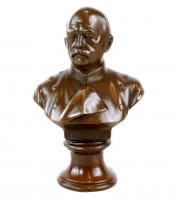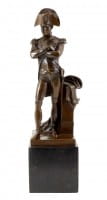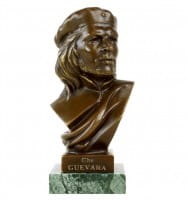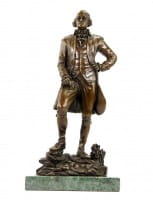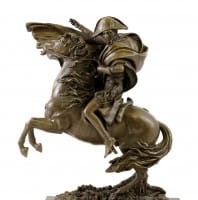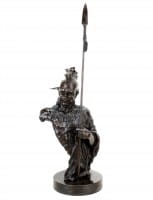Sculptures and bronze figurines of famous military leaders
In the field of Bronze Military Figurines, historical characters are immensely popular, at least when it comes to the bronze bust of the respective person. Some examples are Frederick Wilhelm II. or Emperor Wilhelm. Replicas are often made of famous objects that are steeped in history which are then cast in bronze. One of the most popular motifs is the German spiked helmet which was first used as headgear by the Prussian army in 1834 and that was then consequently adopted as a form of military headgear by a lot of different countries.
Busts - big personalities in your living room
Are you an admirer of big historical figures? In our online shop you are able to buy a bust and take your idol home with you. When you buy a bronze bust and put it up at home, you can experience the graceful charisma of a big personality up close. Our online shop offers you different sculptures of several important historic personalities. Consequently, if you buy a bust, you also buy a piece of commemorative culture. Erect a memorial in your living room in order to show your appreciation for an important historical figure. This act is also a very old and important tradition. For example, in order to raise a sense of national identity, 128 busts of important German personalities were exhibited in Regensburg's Walhalla in 1830. Some famous busts are the one of Karl Marx in Chemnitz or that of Lenin in Ulan-Ude.
In remembrance and recognition of great achievements
Busts are three-dimensional sculptures or relieves of a person that depict the head and a part of the upper body. Often, the origin of head sculptures is said to be Ancient Egypt. However, the figurine of Nefertiti was only a sculptural model. Therefore, it was sort of an experiment and cannot really be called a bust. Even during the Greek and Roman periods, head sculptures as we know them nowadays were not so widely known. Greek art yielded some sculptures of the head of the god Hermes, but other depictions from the Antiquity were just fragments or partial copies of statues.
During the Middle Ages, first relics in the form of head sculptures were created. Only during the Renaissance did portrait busts gain in importance, and during the Baroque period, this form of appreciation was eventually a wide-spread phenomenon. Classicism then was very fond of those portrait busts and adapted the sculptural style of Antiquity. Quite often, deceased persons were commemorated by decorating their graves with their busts. Since the 19th century, countless sculptures were made not only from stone, but also from materials such as bronze or tin.
Karl Marx - the famous "Nischl" for your collection
If you intend to buy a bust of Karl Marx, you should not be easily intimidated. The strict look of this influential German philosopher will cause you to reflect on a lot of things. In our online shop, you can buy a bust of Karl Marx, and acquire a smaller version of Chemnitz' famous "Nischl" (a Saxon word for head) for your home. This sculpture will definitely enrich your collection.
The original "Nischl" is a bust of Karl Marx that is more than 7 metres tall and weighs around 40 tonnes. While the sculpture in the city centre of Chemnitz stylises its model, our Karl Marx bust portrays the philosopher in a more realistic way. Yet, the characteristically strict look is featured in both versions. After the depiction of Lenin in Ulan-Ude, this landmark of Chemnitz is the second largest portrait bust in the world. Furthermore, its placement in the Eastern German city of Chemnitz is no coincidence. After the Second World War, this German city was renamed to Karl-Marx-Stadt and was supposed to become a communist model city. The reconstruction of the city was done after the maxims of a socialistic urban development. The huge bust of Karl Marx was both a monument and a reminder of socialist principles.
Before its erection, the bust was cast in bronze in Leningrad and disassembled into 95 parts for the transport. Once it arrived in Chemnitz, the bust was reassembled. A smaller version that reminds you of this historic portrait bust can be ordered in our online shop.
A recognition of Karl Marx' efforts
Karl Marx was a very well educated man whose theories revolutionised the world. Among other things, he was a philosopher, a social theorist, an economist, a member of the labour movement and a political journalist. He was born in Trier in 1818. His socialist and communist theories, which he postulated together with Friedrich Engels, are still discussed today. His writings significantly shaped the labour movements of the 19th and 20th centuries. The fields of philosophy and social sciences were influenced by Karl Marx as well. He criticised the political economy and discussed the capitalist class conflict, the alienation of work and an alleged fetishised character of consumable goods. His theories caused whole generations to critically think about politics and economy and continue to be heatedly debated.
Together with Friedrich Engels, he made it his goal to create a scientific socialism. As a result, Marxism differentiates itself from early socialism. Marx refused to create communism but rather tried to develop it from the material conditions and the things that humankind learned from history. This development was supposed to necessitate a revolution that was meant to be carried out by the proletariat. According to Marx, a basis for a successful socialism was the dispossession of private property and the seizure of power by the working class. As a result, he hoped for a emergence of a classless society.
Napoleon Bonaparte - general, dictator and emperor
With a bust of Napoleon from our online shop, you honour an influential French military leader and ruler. The bust of Napoleon is reminiscent of the great Napoleon Bonaparte and should not be missing from any Militaria collection. Napoleon came from a Corsican family and pursued a very successful army career during the French revolution. He quickly rose to the top by proving his military talent. Due to the coup of the 18th Brumaire VIII, he got the position of First Consul of the French Republic, which he held from 1799 until 1804. Afterwards, he was crowned emperor of the French people and presided over a dictatorial regime. A military statue of Napoleon Bonaparte therefore shows both an extremely successful military leader as well as a leading political figure.
Napoleon was quite a successful ruler. His reforms of the governmental structures of France continue to have an effect even nowadays, and he also initiated the development of modern civil law. Napoleon's way of ruling was strict and absolute, but also smart and forward-thinking. As a powerful military leader, he obtained power over large parts of continental Europe. He became the king of Italy and accomplished the disintegration of the Holy Roman Empire. However, his ideas concerning a nation made it difficult for him to find enough Spanish, German and Russian followers, which ultimately led to his downfall. A military campaign against Russia ended in a catastrophic outcome and led to his demise in 1912. Even though the end of his rule was not very glorious, he nevertheless should not be missing from any Militaria collection.
Frederick the Great - The old Fritz of Prussia
The old Fritz also earned himself a spot in any Militaria collection, as he was both the king of Prussia as well as the electoral prince of Brandenburg. He fought three wars against Austria, the so-called Silesian Wars, which brought him the hegemony over German territories such as Silesia. The consequence of this was a German dualism, a constant rivalry between Austria and Prussia. The last Silesian War led to the recognition of Prussia as a major power besides Great Britain, Austria, France and Russia. Thus, the old Fritz ensured Prussia a spot in the so-called Concert of Europe. As a representative of Enlightened absolutism and a self-proclaimed servant of the German state, Frederick the Great was an integral part of German history. Yet, he did not only accomplish great political and military achievements. The strong personality of Frederick II. is also worth looking into.
Relationships and the art of Frederick II.
The old Fritz did not maintain a lot of relationships. He frequently corresponded with Voltaire, and invited him to a 14-day long visit to the Rheinsberg Palace. He also liked to surround himself with intellectuals like George Keith, Count Algarotti or Christoph Ludwig von Stille at the Sanssouci Palace. When it comes to women, Frederick II. had high expectations. Thus, he was not granted a lot of profound relationships. He respected Caroline of the Palatinate-Zweibrücken and Catherine II; he maintained a lively contact with the latter via letters, composing numerous poems for her. However, he consequently avoided meeting her. For him, this relationship was of a purely aesthetic nature, and a meeting would dissent from this view. The only profound emotional relationships he had were with his dogs, as "dogs possess all of humankind's positive characteristics without at the same time also possessing its flaws". Consequently, he even had himself buried next to his dogs.
As a writer, the old Fritz was quite an active person. He composed several volumes of the first comprehensive description of the development of Prussia and critically analysed Machiavelli's maxims. All his works were written in French. The members of the German educated classes had differing opinions about his paper on German literature, sometimes they were even quite angry as the German national pride was founded on this literature which was denounced by Frederick's Francophile writings. Thus, one could say that his literary works definitely had an impact. Aside from literature, he cherished all kinds of art. He was a brilliant player of the transverse flute, he composed musical pieces, and he even designed Sanssouci Palace himself.
A versatile and tenacious statesman and military leader
As a part of a Militaria collection, Frederick II. represents a multi-faceted and passionate ruler who enjoyed life in numerous ways. He was also part of several military campaigns, where his adamant will brought him success and fame. During his wars, he also mourned the deaths of close confidantes, but he nevertheless continued to lead his army with an iron fist. His weapons were his intelligence and foresight, both of which he used skilfully.
Emperor Wilhelm the Second - German emperor and King of Prussia
Emperor Wilhelm II. is an integral part of any Militaria collection that focusses on the German Reich. Emperor Wilhelm's full name was Frederick Wilhelm Viktor Albert of Prussia and he descended from the house of Hohenzollern. He was the last German emperor and king of Prussia. He was only 29 years old when he took up his rule in the Year of the Three Emperors in 1888. Due to him becoming the emperor, the German Reich had familial ties to Great Britain, because he was the grandson of Queen Victoria. Wilhelm had a rather conservative understanding of an imperial rule. Therefore, he was not in favour of a constitutional monarchy. Only when the defeat of the First World War put pressure on him did he agree to a reform. However, this did not stop the Entente powers from persecuting him for his war crimes. Wilhelm II. fled to the Netherlands, where Queen Wilhelmina granted him asylum until his death.
Prestige, influence and a failed world power - the Wilhelmine period
Wilhelm II. reigned over the German Reich for 30 years until its collapse in 1918. As an emperor, he wanted the Reich to become a political entity and to consolidate its position among the world powers. For this purpose, he put a special emphasis on acquiring international reputation and prestige. Military armament was a logical consequence of this pursuit of recognition. Additionally, he promoted a colonial policy in the South Pacific and Africa. However, this and the involvement in several international crises led to an instability within the German Reich.
During the Wilhelmine period, numerous parades were arranged, as the emperor had an affinity for military splendour. Consequently, various different events were used as an excuse to hold a military parade. The overemphasis of the military led to a militarism in which a person without any military rank was hardly able to achieve anything. Without a military rank, a successful career was unthinkable, and the rank of a reserve officer was like a door opener into high society. There was hardly any separation between civil and military life. During the Wilhelmine period, Germany went through an economic boom, the Golden Twenties were imminent. The whole Reich experienced a rapid progress in the fields of science and technology and internally flourished due to Bismarck's social policies, which were continued and extended by Wilhelm II. In the field of foreign affairs, Wilhelm II. strived for more power. His goal was to surpass his father, which also made him rather erratic. He led a fast-changing personal regiment whose advisers had different influences on him. This led to decisions that were hardly understandable and sometimes even contradictory. One example for this was the Morocco Crisis. In the end, the course and defeat of the First World War were proof of Wilhelm's lacking tactical skills. His defeat led to an end of the monarchy and the beginning of the Weimar Republic.
Military Statues for sale in our online shop
In our shop you will find a wide selection of Military statues for sale, ranging from depictions of important personalities to military objects or a bronze figurine of a spiked helmet. Our prices for every object of course already include sales tax, to which only shipping costs are added. The cost of shipping is calculated according to the weight of your chosen article and amounts to at least €6.70, but will not be higher than €13.00 within Germany. Within Germany we can guarantee a delivery period of no more than 48 hours, so you will soon be able to receive your purchased object and enjoy it for an even longer period of time.
If you have questions concerning the shipment, the delivery period or the articles themselves, just contact us via the link to our contact form at the end of this site.













